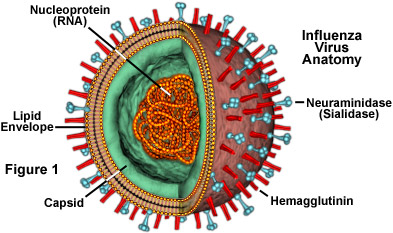
The flu virus.
The flu is a respiratory illness caused by the influenza virus. There are three types of influenza virus, A, B and C. A and B types are known to cause flu like symptoms in humans. Type C is rare in humans and only causes mild symptoms. The molecular biology of the influenza virus is complex and its full mechanism of action is still unclear. However it is clear that an effective anti flu Vaccine will never be developed due to the rapid mutations observed in the virus. Once a vaccine has been produced for a known strain, the virus quickly mutates and develops resistance to the antiviral antigen. Vaccines are produced each year for known A and B type influenza, despite this new strains can still infect even fully vaccinated people. This is the reason why a flu strain can often escalate into epidemic and even pandemic proportions.
The structure of the influenza A virus is shown bellow:

The Virus strains are characterised by the nature of the two proteins found on there surface, namely Neuraminidase and Hemagglutinin. Approximately 80 percent of the spikes are hemagglutinin, a trimeric protein that functions in the attachment of the virus to a host cell. The remaining 20 percent or so of the glycoprotein spikes consist of neuraminidase, which is thought to be predominantly involved in facilitating the release of newly produced virus particles from the host cell. The inner of the cell contains the RNA nucleotides which are the genetic code for the virus replication.
There are 15 different hemagglutinin subtypes and 9 Neuraminidase subtypes. It will be often found in literature codes like AH5N1, Which stands for A type influenza, Subtype 5 hemagglutinin and subtype 1 neuraminidase. This type is the common avian bird flu which has recently spread to humans and is causing much worry. It has been found that strains of H5 and H7 are the most deadly and can cause widespread death in animals.
micro.magnet.fsu.edu/.../ influenzavirus.html
The Influenza virus is thought to originate in birds and spread to other animals such as pigs and cows. Most strains never pass from birds to humans however occasionally one does mutate and pass from human to human which can cause a flu outbreak.